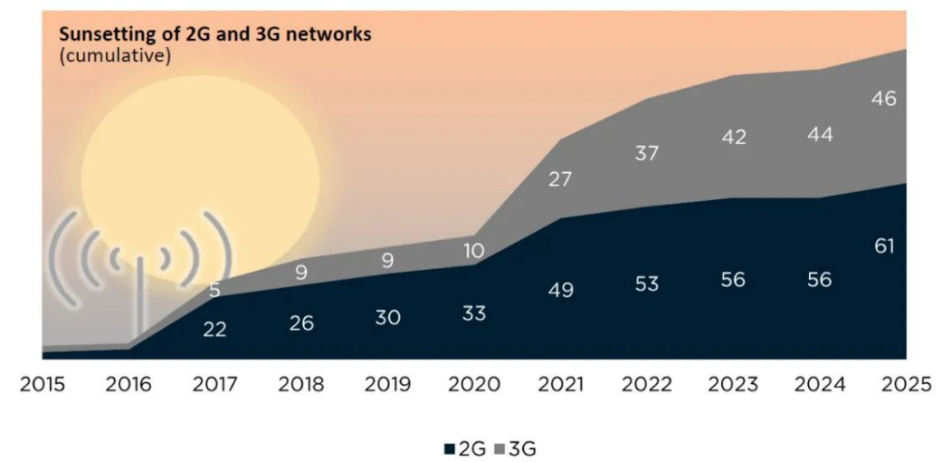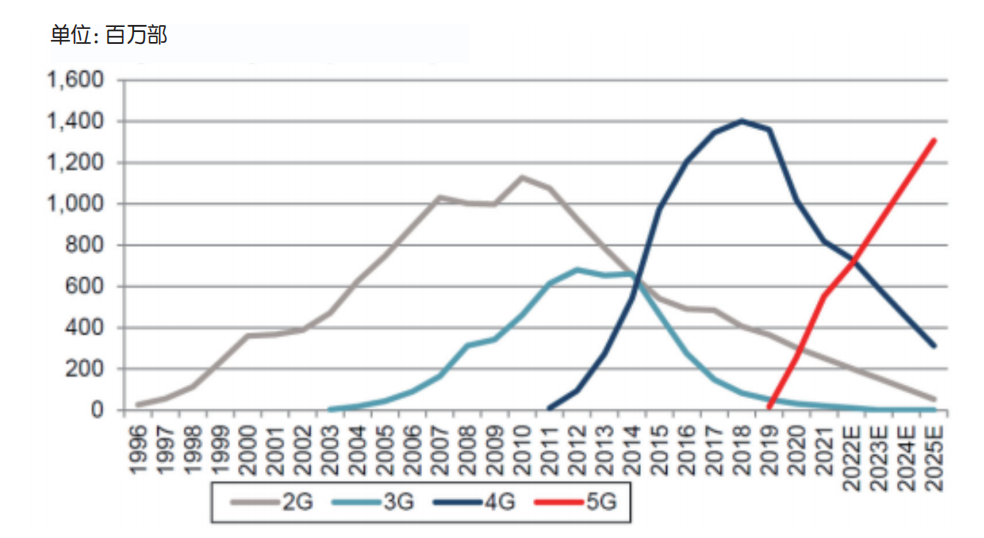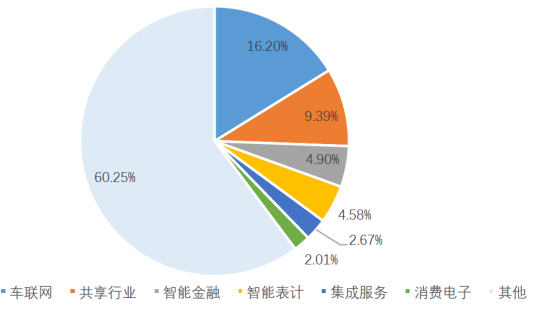5G accelerates my country's 2G/3G withdrawal process

Recently, British mobile operator 3 UK (Three UK) decided to shut down its 3G mobile service by the end of 2024. Two other UK operators, Vodafone and BT, have previously made similar announcements that they will shut down their 3G networks in 2023. The three major U.S. telecom operators plan to completely shut down 3G networks in 2022.
In the wireless communications industry, shutting down outdated networks is often because telecom operators want to use limited spectrum resources for more efficient network technologies. For example, AT&T shut down its 2G network in 2017 in order to improve 3G network coverage and promote 4G popularization as soon as possible.
5G network construction accelerates the process of 2G/3G network withdrawal
With the large-scale commercial development of 4G/5G, the global 2G/3G withdrawal process is accelerating. Figure 1 shows the global 2G/3G network withdrawal in recent years according to GSMA statistics. It is estimated that by 2025, a total of 61 2G networks and 46 3G networks will be closed globally. At present, countries and regions such as the United States, Germany, Australia, New Zealand, Singapore, Japan, South Korea, Vietnam, and Macau, China have carried out 2G/3G network withdrawal work.

Figure 1 Statistics and forecast of global 2G/3G network withdrawal (Source: GSMA)

Figure 2 Comparison and forecast of 2G/3G/4G/5G mobile phone shipments over the years (Source: Credit Suisse)
However, from a global perspective, the life cycle of 2G (GSM) is quite long. Even if 3G/4G/5G appeared one after another, 2G has not been completely replaced so far. This can be seen from the comparison and forecast chart of 2G/3G/4G/5G mobile phone shipments drawn by Credit Suisse over the years (see Figure 2).
Operators have accumulated rich experience in 2G/3G network withdrawal
Since 2008, some telecom operators around the world have successively launched 2G/3G network withdrawals, and have accumulated rich experience so far, as follows.
One is to ensure that alternative networks have the same level of service. This is the premise of closing the old network. For this reason, during the transition period of network withdrawal, a 2G thin network should be reserved to carry roaming services, otherwise it will affect users' trust in telecom services. For example, in Germany, although the 3G network has already been shut down, in order to maintain the continuity of the voice business, the 2G network is still reserved.
The second is to allow a sufficient transition period before shutting down the old network. According to the practice of foreign telecom operators, the transition period is usually about 3 years. Telecom operators should inform users in advance through various channels about the arrangement plan of the withdrawal time and route, and provide users with various compensation or incentive measures, including providing Various discounted phone bills and mobile terminals, assistance in recycling old mobile phones, etc. For example, in the United States, AT&T once provided services such as free mailing of smart phones to users in remote areas.
The third is to properly handle the negotiation and communication with industry units. Telecom operators should formulate detailed 2G/3G network withdrawal plans in advance, and especially strengthen negotiations with industry units. For example, before shutting down its 3G network, AT&T offered enterprise customers more than $100 million in incentives to replace outdated 3G equipment and tailor solutions for enterprise customers with unique transition needs.
The fourth is to accelerate the progress with the assistance of industry regulators. Telecom operators should work with industry regulators to publicize relevant measures for network withdrawal to the public, negotiate and formulate a plan to gradually withdraw 2G/3G terminals from the market, so as to cut off the source of new 2G/3G equipment entering the network. For example, Vietnam has formulated the following policies: starting from 2022, the mobile communication terminal equipment manufactured or imported must support 4G technology; starting from September 2024, the license for 2G/3G technology will not be extended.
Telecom operators' 2G/3G withdrawal from the network is still hindered by many parties
Although telecom operators have formulated 2G/3G network withdrawal policies, there will still be resistance from ordinary users, industry enterprises and public organizations to completely shut down 2G/3G networks. Take AT&T in the United States as an example to shut down its 3G network. As early as 2020, when AT&T informed the public of its 3G withdrawal plan, it received a large number of user complaints. Since then, the Alarm Industry Communications Commission has proposed to the Federal Communications Commission that due to time constraints, it is too late to complete the upgrade and transformation of all equipment systems. Some law enforcement agencies, home and car tracking and monitoring equipment are still using 3G, and closing 3G will bring "significant public". Security Risk". The Alert Industry Communications Council also believes that AT&T's transition plan for it has not yet proven to ensure immediate restoration of service in the event of a major outage to critical systems. For the same reason, the timing of T-Mobile's 2G shutdown has yet to be determined, even though its 2G/3G traffic accounts for less than 1%.
2G/3G network withdrawal is an inevitable option for the conversion of new and old kinetic energy
First, the vacated frequency resources of 2G/3G will promote the accelerated improvement and development of 4G/5G. 2G/3G has long been an outdated technology, with insufficient network speed, capacity, and frequency efficiency, but the low-frequency resources occupied by it have natural advantages such as wide signal coverage and strong penetration ability. technology, will greatly reduce construction and operating costs, and improve the efficiency of resource use.
Second, the cellular Internet of Things and broadband voice technologies promoted by my country can well replace 2G/3G. 2G/3G mainly carries voice calls and medium and low-speed data services. The NB-IoT (Narrowband Internet of Things), 4G (including Cat1, VoLTE) and 5G technologies currently promoted by my country can just completely fill the technical gap after 2G/3G is withdrawn from the network. .
Third, shutting down 2G/3G networks is an inevitable choice for implementing green, low-carbon and network security strategies. Shutting down 2G/3G can reduce energy and consumption, save operation and maintenance expenses and license fees, and facilitate telecom operators to focus on developing 4G/5G with light equipment. Due to the incomplete 2G/3G base station authentication mechanism, shutting down the 2G/3G network can eliminate some criminal acts such as hacker eavesdropping and fake base station fraud, and eliminate some hidden dangers that endanger user information security and public security.
Domestic 2G/3G network withdrawal policy is becoming clearer
In November 2021, the "14th Five-Year Plan" Information and Communication Industry Development Plan issued by the Ministry of Industry and Information Technology clearly stated that "accelerating the withdrawal of 2G and 3G networks, and coordinating the coordinated development of 4G and 5G networks", the withdrawal of 2G/3G networks was included in the "Tenth Five-Year Plan". The key work of network infrastructure during the Fourth Five-Year Plan period. Prior to this, in May 2020, the Ministry of Industry and Information Technology issued the "Notice on Further Promoting the Comprehensive Development of the Mobile Internet of Things", which for the first time clearly proposed "promoting the migration of 2G/3G Internet of Things services". Telecom operators have also issued a number of 2G/3G network withdrawal documents, such as China Mobile's request to stop adding 2G IoT users before the end of 2020; China Telecom is pushing to gradually migrate 2G voice services to VoLTE, and requires 5G terminals to no longer support 2G; China Unicom released a 2G/3G withdrawal plan to encourage 2G users to upgrade to 4G/5G.
Difficulties faced by 2G/3G network withdrawal
The withdrawal of equipment from the network is not a simple technical or economic problem. At present, my country's 2G/3G network withdrawal is faced with the following difficulties.
First, the scale of 2G/3G is huge, and the process of withdrawing from the network should not be "one size fits all". By the end of 2021, the scale of 2G/3G base stations will still reach 2.635 million, accounting for more than 26% of the total base stations. 2G/3G networks still carry hundreds of millions of mobile phone users and IoT users, of which China Mobile's 2G network is the largest, carrying nearly 90% of users. In some areas, telecom operators have started the shutdown of some 2G/3G base stations, but due to the inappropriate network withdrawal plan, some negative public opinions have been triggered.
Second, new 2G/3G IoT terminals are still being shipped. According to statistics, 2G/3G non-mobile phone terminal shipments will reach 15.01 million units in 2021, a year-on-year decrease of 69.7%, but still present a situation of "prosperous production and sales". Once the terminal equipment is connected to the network, it undertakes important production and operation tasks for industry users, and the IoT terminal has a long iteration cycle. Taking smart meter reading as an example, it can reach 7 to 15 years, which will bring hidden dangers to the complete withdrawal of 2G/3G from the network in the future.
The third is the heavy task of migrating 2G/3G stock services. For 2G/3G IoT services, the research conducted by China Mobile Research Institute is shown in Figure 3. Currently, the IoT services mainly carried include the Internet of Vehicles, sharing industries, smart finance, smart meters, consumer electronics, etc., involving a large number of historical asset issues , including existing communication modules, and even who will pay for the upgrade of production equipment. For the 2G/3G mobile phone business, most of the 2G user terminals are functional phones for the elderly, and some are phone watches for children. According to the survey, there is still a market for low-priced 2G feature phones, and there is still a price difference of tens of yuan between them and 4G feature phones, so they are welcomed by some elderly people. According to statistics, 2G/3G mobile phone terminal shipments will reach 4.17 million units in 2021, a year-on-year decrease of 52.3%, but there are still 12 new 2G/3G mobile phone products on the market.

Figure 3 The proportion of 2G mobile IoT traffic (source: China Mobile Research Institute)
Fourth, alternative technologies still face network and industry problems. 2G/3G networks carry medium and low-speed IoT services. Although 4G/5G network technologies are substitutable, the following problems are still faced in order to achieve network transfer as soon as possible. First, NB-IoT network coverage is limited. At present, the deployment of NB-IoT networks of telecom operators is limited, and the coverage level of NB-IoT networks in some areas cannot fully meet the requirements of carrying 2G/3G connection migration, and the depth of local coverage needs to be strengthened. Second, the cost of 4G Cat1/5G terminal modules is not low enough. 4G Cat1 technology can be quickly deployed through 4G networks, but since the first modules will be available at the end of 2019, it will take at least three years to achieve the same price and quality as 2G modules.
Some Suggestions for Orderly Promoting my country's 2G/3G Retirement
The elimination of 2G/3G "old kinetic energy" has positive significance for the sustainable development of my country's information and communication industry. However, my country's 2G/3G network withdrawal task is heavy and the situation is complicated. While learning from the existing 2G/3G network withdrawal experience abroad, it is necessary to steadily promote the 2G/3G network withdrawal work based on the actual situation, and implement the 14th Five-Year Plan for the information and communication industry. Require.
Recommendation - Deploy 2G/3G network withdrawal plan as soon as possible
In order to properly handle the withdrawal of existing 2G/3G users, telecom operators should deploy the direction and path of 2G/3G withdrawal in advance, and consider conducting 2G/3G withdrawal work in stages, regions and frequency bands, and advance through multiple channels. Users and industry units should inform the 2G/3G network withdrawal policy, make preparations for 2G/3G network withdrawal including psychological thoughts, etc., and negotiate with industry units in advance about the 2G/3G service withdrawal and transfer plan.
Recommendation 2: Ensure that 2G/3G network withdrawals do not reduce services
Telecom operators should continue to optimize alternative networks, and in areas where 2G/3G networks are shut down, to ensure that alternative networks reach or even exceed the original 2G/3G level in terms of signal coverage and service quality. During the transition period, consider keeping a 2G thin network as an emergency backup; and provide 4G/5G mobile phone rental services for foreign tourists at the airport entry and exit to undertake international roaming business.
Suggestion 3 Speed up the transfer of 2G/3G stock services to the network
Telecom operators should carry out market-accurate marketing services in advance, and launch some attractive network switching incentives or targeted communication plans, including providing 4G/5G preferential packages, launching discounted smartphone sales activities, and providing smart phone use skills training for the elderly. Develop smart terminals suitable for the elderly, communicate and negotiate Internet of Things transfer solutions, etc.
Four major efforts are recommended to promote NB-IoT/4G Cat1/5G applications
Promote the maturity of the 4G Cat1/5G module industry, build NB-IoT networks on demand, and form a mobile IoT ecological development pattern with NB-IoT/4G Cat1/5G as the "troika" as soon as possible, and enhance the use of advanced mobile technologies ratio, stimulate the endogenous power of 2G/3G stock business to accelerate the migration to NB-IoT/4G Cat1/5G, and accelerate the prosperity of 4G/5G applications.
Suggestion 5: Plan ahead for 2G/3G frequency re-farming
The telecommunications industry regulatory agency should carry out electromagnetic compatibility research in advance, deal with the interference protection and coordination between various business systems, and start frequency planning and adjustment work such as 800MHz/900MHz/1800MHz/1900MHz/2100MHz in a timely manner.